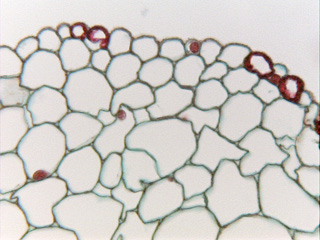 Fig.
10.2-6. Transverse section of Indian-pipe stem (Monotropa).
Indian-pipe is parasitic
plant, one that attacks the roots of its host plant. Its body is a
subterranean, irregular mass of tissue that produces an inflorescence stalk that
pushes upward and raises the flowers above the soil surface where they can be
seen by pollinators. This inflorescence stalk is only a temporary structure, and
it has a very “inexpensive” construction: it consists mostly of parenchyma
and the epidermis cells have so little cuticle that it cannot be seen at this
magnification.
Fig.
10.2-6. Transverse section of Indian-pipe stem (Monotropa).
Indian-pipe is parasitic
plant, one that attacks the roots of its host plant. Its body is a
subterranean, irregular mass of tissue that produces an inflorescence stalk that
pushes upward and raises the flowers above the soil surface where they can be
seen by pollinators. This inflorescence stalk is only a temporary structure, and
it has a very “inexpensive” construction: it consists mostly of parenchyma
and the epidermis cells have so little cuticle that it cannot be seen at this
magnification.